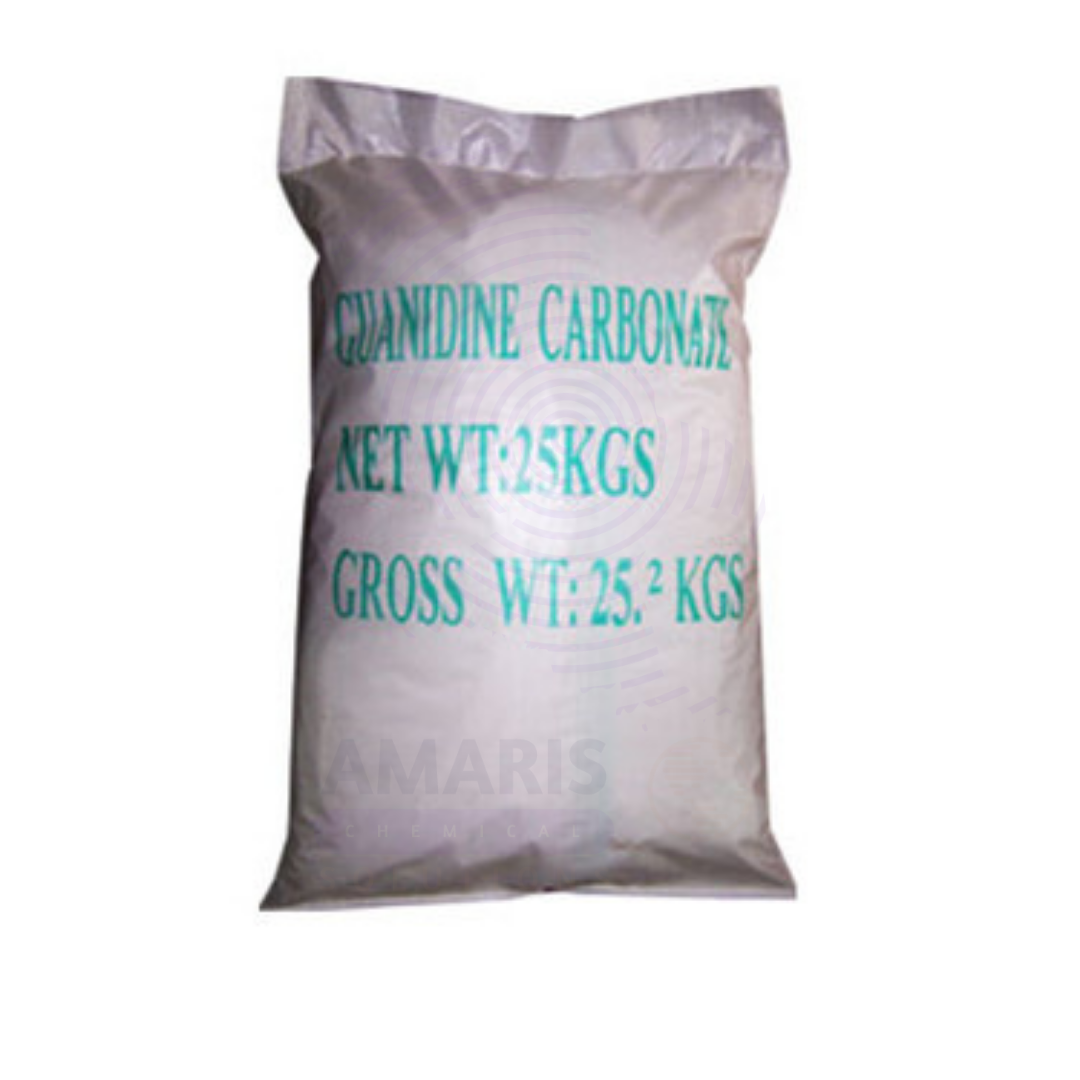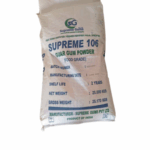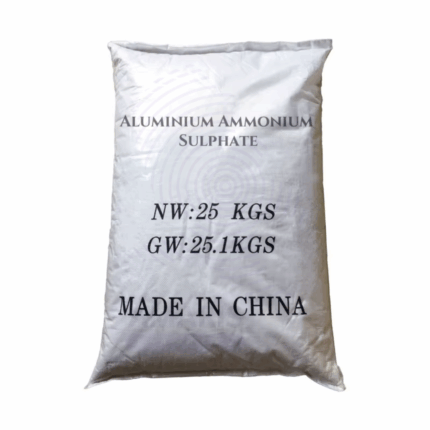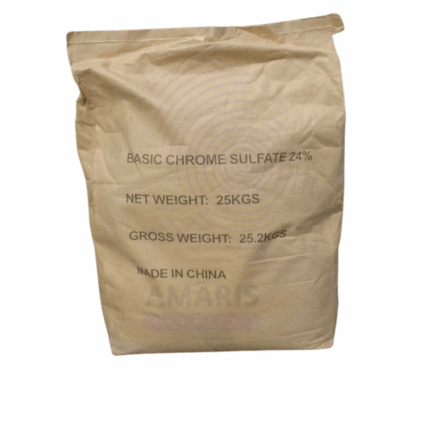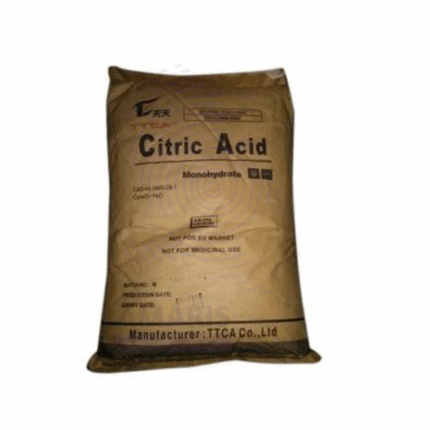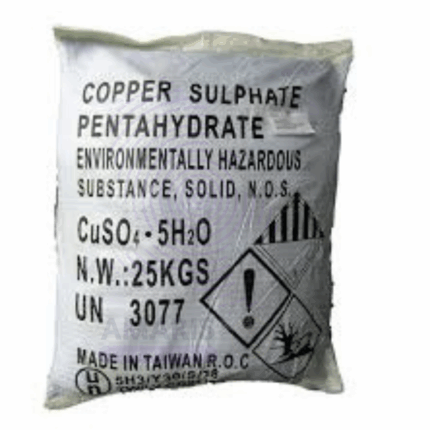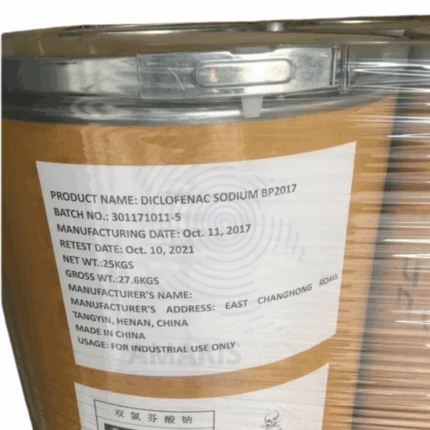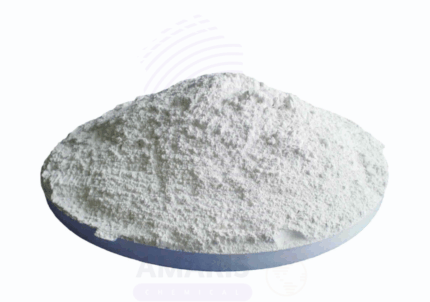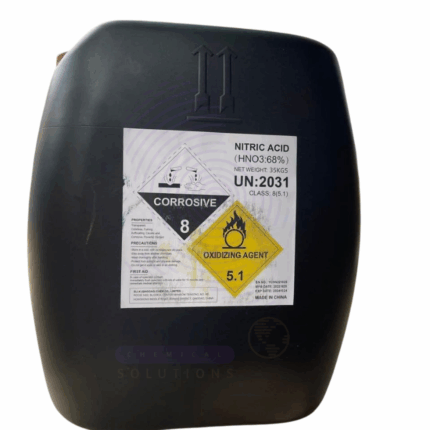Guanidine Carbonate
Whatsapp Order
Guanidine Carbonate is a white crystalline powder, highly soluble in water, with strong basicity and high nitrogen content. It’s a versatile chemical intermediate widely used in pharmaceuticals, agriculture, polymer chemistry, textiles, and laboratory research. Its buffering properties and reactivity make it valuable in synthesis, pH regulation, and as a nitrogen source.
Description
Table of Contents
Toggle
Guanidine Carbonate
Primary Uses
- Pharmaceutical Industry
- Precursor in the synthesis of antidiabetic drugs such as metformin and related biguanides.
- Intermediate for antiviral, antihypertensive, and antibacterial compounds containing guanidine moieties.
- Used in formulation pH control and buffering systems for stable drug preparations.
- Incorporated in veterinary medicines for similar pharmaceutical applications.
- Agriculture
- Used as a nitrogen-rich fertilizer to promote plant growth and yield.
- Intermediate in the synthesis of herbicides, insecticides, and fungicides.
- Functions as a soil conditioner by moderating pH and improving nutrient availability.
- Chemical Industry
- Key raw material in production of guanidine-based resins, adhesives, and curing agents for epoxy and polyurethane systems.
- Employed in the textile industry for dye fixation and as a pH buffer during fabric processing.
- Used in rubber vulcanization accelerators and in manufacture of plasticizers.
- Important reagent in organic synthesis for preparation of amidines, guanidines, and heterocyclic compounds.
- Used in the manufacture of dyes, pigments, and photographic chemicals.
- Laboratory and Research
- Utilized as a denaturant for proteins and nucleic acids in molecular biology research.
- Employed in biochemical assays and enzymatic reactions requiring controlled pH.
- Used as a reagent in analytical chemistry and synthetic organic chemistry protocols.
Secondary Uses
- Cosmetics and Personal Care
- Used in trace amounts as a pH adjuster and buffering agent in skincare and cosmetic formulations.
- Environmental and Wastewater Treatment
- Investigated as an agent for removing heavy metals and nitrogenous wastes from contaminated water.
- Utilized in biodegradation enhancement during treatment of industrial effluents.
- Food Industry
- Occasionally used as a processing aid or pH regulator in niche food applications (regulated and limited).
- Miscellaneous
- Employed in corrosion inhibitors for metal protection in industrial processes.
- Used in photographic chemical preparations and flame retardants synthesis.
- Investigated as an intermediate in battery electrolyte formulations and fuel additives.
KEY PRODUCT FEATURES
1. Basic Identification Attributes
- Chemical Name (IUPAC): Guanidinium carbonate
- Common/Trade Name: Guanidine Carbonate
- CAS Number: 593-85-1
- HS Code: 2921.49.00
- Molecular Formula: C2H8N4O3
- Molecular Weight: 116.09 g/mol
- Synonyms: Guanidinium carbonate; Carbonic acid guanidine salt; Guanidine bicarbonate (related)
2. Physical & Chemical Properties
- Physical State: Crystalline powder
- Color & Odor: White; odorless
- Melting Point: Decomposes above 160 °C
- Solubility: Highly soluble in water; slightly soluble in alcohol
- pH (1% aqueous solution): Alkaline (~11)
- Stability: Stable under normal conditions
3. Safety & Hazard Attributes
- GHS Classification: Not classified hazardous; alkaline substance
- Toxicity: Low; mild irritant potential
- Irritation: May irritate skin, eyes, respiratory tract upon exposure
4. Storage & Handling Attributes
- Container Type: Sealed polyethylene bags or drums
- Storage Conditions: Cool, dry, ventilated area away from moisture and acids
- Shelf Life: 2–3 years
- Handling Notes: Avoid dust; PPE recommended
5. Regulatory & Compliance Attributes
- Complies with REACH, industrial chemical safety standards
- Approved for use in manufacturing across regulated industries
6. Environmental & Health Impact
- Biodegradability: Biodegradable
- Ecotoxicity: Low at environmental concentrations
- Bioaccumulation: Not expected
- Carcinogenicity/Mutagenicity: None known
SAFETY HANDLING PRECAUTIONS
Safety Handling Precautions
- PPE Required: Gloves, goggles, dust mask/respirator
- Handling Guidelines: Avoid dust inhalation, skin and eye contact; use adequate ventilation
- Hygiene Practices: Wash hands after handling; no food/drink in work areas
First Aid Measures
- Inhalation: Fresh air, seek medical help if symptoms persist
- Skin Contact: Wash with soap and water; seek medical advice if irritated
- Eye Contact: Rinse thoroughly with water for 15+ minutes; consult physician if irritation remains
- Ingestion: Rinse mouth, do not induce vomiting; seek immediate medical care
Firefighting Measures
- Fire Hazards: Not highly flammable; decomposes releasing toxic gases under intense heat
- Extinguishing Media: Water spray, foam, dry chemical, CO₂
- Combustion Products: Nitrogen oxides, carbon monoxide, carbon dioxide
- Firefighter PPE: SCBA and protective clothing
Related products
Aluminum Ammonium Sulphate
Aluminum ammonium sulphate, commonly known as ammonium alum or ammonium aluminum sulfate, is a crystalline chemical compound consisting of aluminum, ammonium, and sulfate ions. It typically appears as a colorless or white crystalline solid with astringent properties. It is widely used for its excellent coagulating, clarifying, and antiseptic properties. Aluminum ammonium sulphate finds applications in water purification, cosmetics, food processing, textile dyeing, and pharmaceuticals. Its ability to precipitate impurities and act as a mordant makes it invaluable in industries requiring precise control of chemical reactions, such as in the preparation of baking powder and fireproof textiles.
Basic Chrome
Basic Chrome Sulfate, commonly referred to as Basic Chrome, is a chromium-based chemical compound primarily used in the leather tanning industry. It appears as a greenish crystalline powder and contains chromium(III) sulfate complexed with basic chromium salts. Basic Chrome is favored for its ability to produce soft, flexible, and durable leather by crosslinking collagen fibers. It is the most widely used tanning agent worldwide due to its effectiveness and cost-efficiency. Besides tanning, Basic Chrome finds applications in other industries like pigments and catalysts.
Citric Acid Monohydrate
Citric Acid Monohydrate is a white, crystalline powder or granule form of citric acid containing one molecule of water per molecule of acid. It is a natural organic acid commonly derived from citrus fruits or produced by fermentation processes. Citric Acid Monohydrate is widely used as an acidulant, preservative, and chelating agent in various industries. Compared to the anhydrous form, it has a slightly lower acid concentration due to the water molecule but offers excellent solubility and stability. It is prized for its sour flavor, buffering capacity, and ability to bind metal ions, making it indispensable in food, pharmaceutical, cosmetic, and industrial applications.
Copper Sulphate Pentahydrate
Copper Sulphate Pentahydrate (CuSO₄·5H₂O) is a bright blue crystalline solid widely used as a chemical reagent, agricultural fungicide, and analytical reagent. It consists of copper, sulfur, oxygen, and water molecules, forming a distinctive pentahydrate structure. This inorganic salt is highly soluble in water, exhibiting antifungal, algaecidal, and bactericidal properties. Copper Sulphate Pentahydrate is extensively employed in agriculture, industry, and laboratory applications due to its effectiveness, affordability, and well-understood chemistry.
Diclofenac Sodium BP
Diclofenac Sodium is a nonsteroidal anti-inflammatory drug (NSAID) widely used for its potent analgesic, anti-inflammatory, and antipyretic properties. It is the sodium salt form of diclofenac, providing enhanced solubility and rapid absorption. Diclofenac Sodium BP (British Pharmacopoeia standard) ensures pharmaceutical-grade purity and compliance with stringent quality standards. It is commonly formulated in oral tablets, topical gels, injections, and ophthalmic preparations.
Dicumyl Peroxide
Dicumyl Peroxide (DCP) is a widely used organic peroxide with powerful free radical initiator properties. It appears as a white crystalline solid with a characteristic odor and is primarily employed as a cross-linking agent and polymerization initiator in the plastics and rubber industries. Due to its ability to generate free radicals upon thermal decomposition, it facilitates curing and cross-linking of polymers, improving mechanical properties and heat resistance. Dicumyl Peroxide is a key component in manufacturing processes for polyethylene, polypropylene, EPDM rubber, and other elastomers.
Diloxanide Furoate
Diloxanide Furoate is an orally administered antiprotozoal agent used primarily for the treatment of amoebiasis. It is a furan-based derivative that acts as a luminal amoebicide, effectively targeting Entamoeba histolytica cysts and trophozoites within the intestinal lumen. This compound is well-regarded for its efficacy in eradicating asymptomatic cyst carriers and as a follow-up treatment after systemic amoebicidal therapy. Diloxanide Furoate has good oral bioavailability and a favorable safety profile.
Nitric Acid
Nitric Acid is a concentrated aqueous solution of nitric acid (HNO₃) commonly used as a strong oxidizing acid in numerous industrial, laboratory, and manufacturing processes. It is a highly corrosive, colorless to yellowish liquid with a pungent odor. Nitric Acid 68% is fundamental in the production of fertilizers, explosives, dyes, and pharmaceuticals. It is also widely used in metal treatment, etching, and cleaning applications due to its powerful oxidizing and nitrating properties.


 Preservatives(food)
Preservatives(food) Flavor Enhancers
Flavor Enhancers Acidulants
Acidulants Sweeteners
Sweeteners Antioxidants
Antioxidants Colorants(food)
Colorants(food) Nutraceutical Ingredients (food)
Nutraceutical Ingredients (food) Nutrient Supplements
Nutrient Supplements Emulsifiers
Emulsifiers
 Collectors
Collectors Dust Suppressants
Dust Suppressants Explosives and Blasting Agents
Explosives and Blasting Agents Flocculants and Coagulants
Flocculants and Coagulants Frothers
Frothers Leaching Agents
Leaching Agents pH Modifiers
pH Modifiers Precious Metal Extraction Agents
Precious Metal Extraction Agents
 Antioxidants(plastic)
Antioxidants(plastic) Colorants (Pigments, Dyes)
Colorants (Pigments, Dyes) Fillers and Reinforcements
Fillers and Reinforcements Flame Retardants
Flame Retardants Monomers
Monomers Plasticizers
Plasticizers Polymerization Initiators
Polymerization Initiators Stabilizers (UV, Heat)
Stabilizers (UV, Heat)
 Antifoaming Agents
Antifoaming Agents Chelating Agents
Chelating Agents Coagulants and Flocculants
Coagulants and Flocculants Corrosion Inhibitors
Corrosion Inhibitors Disinfectants and Biocides
Disinfectants and Biocides Oxidizing Agents
Oxidizing Agents pH Adjusters
pH Adjusters Scale Inhibitors( water)
Scale Inhibitors( water)
 Antioxidants(cosmetic)
Antioxidants(cosmetic) Emollients
Emollients Fragrances and Essential Oils
Fragrances and Essential Oils Humectants
Humectants Preservatives
Preservatives Surfactants(cosmetic)
Surfactants(cosmetic) Thickeners
Thickeners UV Filters
UV Filters
 Fertilizers
Fertilizers Soil Conditioners
Soil Conditioners Plant Growth Regulators
Plant Growth Regulators Animal Feed Additives
Animal Feed Additives Biostimulants
Biostimulants Pesticides (Herbicides, Insecticides, Fungicides)
Pesticides (Herbicides, Insecticides, Fungicides)
 Active Pharmaceutical Ingredients (APIs)
Active Pharmaceutical Ingredients (APIs) Excipients
Excipients Solvents(pharmaceutical)
Solvents(pharmaceutical) Antibiotics
Antibiotics Antiseptics and Disinfectants
Antiseptics and Disinfectants Vaccine Adjuvants
Vaccine Adjuvants Nutraceutical Ingredients (pharmaceutical)
Nutraceutical Ingredients (pharmaceutical) Analgesics & Antipyretics
Analgesics & Antipyretics
 Analytical Reagents
Analytical Reagents Solvents(lab)
Solvents(lab) Chromatography Chemicals
Chromatography Chemicals Spectroscopy Reagents
Spectroscopy Reagents microbiology-and-cell-culture-reagents
microbiology-and-cell-culture-reagents Molecular Biology Reagents
Molecular Biology Reagents Biochemical Reagents
Biochemical Reagents Inorganic and Organic Standards
Inorganic and Organic Standards Laboratory Safety Chemicals
Laboratory Safety Chemicals Specialty Laboratory Chemicals(Special Laboratory Equipment)
Specialty Laboratory Chemicals(Special Laboratory Equipment)
 Demulsifiers
Demulsifiers Hydraulic Fracturing Fluids
Hydraulic Fracturing Fluids Scale Inhibitors(oil)
Scale Inhibitors(oil) Surfactants(oil)
Surfactants(oil) Drilling Fluids
Drilling Fluids
 Dyes and Pigments
Dyes and Pigments Bleaching Agents
Bleaching Agents Softening Agents
Softening Agents Finishing Agents
Finishing Agents Antistatic Agents
Antistatic Agents
 Admixtures
Admixtures Waterproofing Agents
Waterproofing Agents Sealants and Adhesives
Sealants and Adhesives Curing Compounds
Curing Compounds Concrete Repair Chemicals
Concrete Repair Chemicals Anti-Corrosion Coatings
Anti-Corrosion Coatings
 Surfactants(cleaning)
Surfactants(cleaning) Builders
Builders Enzymes
Enzymes Solvents (Cleaning)
Solvents (Cleaning) Fragrances
Fragrances
 Electronic Chemicals
Electronic Chemicals Catalysts
Catalysts Lubricants
Lubricants Photographic Chemicals
Photographic Chemicals Refrigerants
Refrigerants Automotive chemicals
Automotive chemicals Pyrotechnic Chemicals
Pyrotechnic Chemicals
 Biodegradable Surfactants
Biodegradable Surfactants Bio-based Solvents
Bio-based Solvents Renewable Polymers
Renewable Polymers Carbon Capture Chemicals
Carbon Capture Chemicals Wastewater Treatment Chemicals
Wastewater Treatment Chemicals
 Pigments
Pigments Solvents(paint)
Solvents(paint) Specialty Coatings
Specialty Coatings Binders/Resins
Binders/Resins Additives
Additives Driers
Driers Anti-Corrosion Agents
Anti-Corrosion Agents Functional Coatings
Functional Coatings Application-Specific Coatings
Application-Specific Coatings
 Fresh Herbs
Fresh Herbs Ground Spices
Ground Spices Whole Spices
Whole Spices Spice Blends
Spice Blends Dried Herbs
Dried Herbs
 Leavening Agents
Leavening Agents Dough Conditioners
Dough Conditioners Flour Treatments
Flour Treatments Fat Replacers
Fat Replacers Decoratives
Decoratives Preservatives(baking)
Preservatives(baking)
 Plasticizers & Softeners
Plasticizers & Softeners Reinforcing Agents
Reinforcing Agents Adhesion Promoters
Adhesion Promoters Vulcanizing Agents
Vulcanizing Agents Antidegradants
Antidegradants Blowing Agents
Blowing Agents Fillers & Extenders
Fillers & Extenders Accelerators & Retarders
Accelerators & Retarders